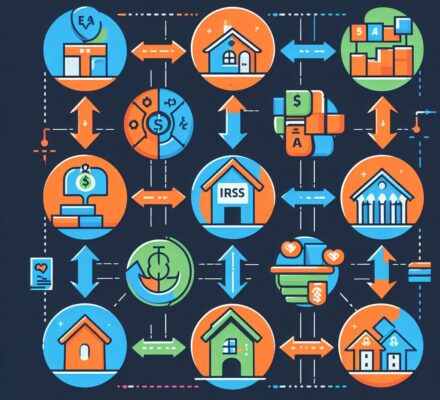Are you curious about the rules for 1031 exchanges? Well, get ready to dive into the technical details of this tax-deferral strategy.
In this article, we will explore the eligible properties, timeframe, and like-kind property requirements for a successful exchange.
We will also discuss the important role of qualified intermediaries and the tax implications you need to be aware of.
Stay tuned to uncover the secrets behind 1031 exchanges!
Key Takeaways
- Eligible properties for a 1031 exchange include real estate held for investment or business purposes, such as residential rental properties, commercial properties, vacant land, and certain types of personal property used in a trade or business.
- Primary residences or second homes are not eligible for a 1031 exchange.
- The timeframe for completing a 1031 exchange is 45 days to identify potential replacement properties and 180 days to complete the exchange, including closing on the identified replacement property.
- The properties involved in the exchange must be of the same nature or character and must be held for investment or productive use in a trade or business. Personal residences or properties used primarily for personal purposes do not qualify.
Eligible Properties for 1031 Exchanges
To qualify for a 1031 exchange, you must ensure that the property you’re considering is eligible for the exchange. Eligible properties include real estate held for investment or business purposes. This can include residential rental properties, commercial properties, vacant land, and even certain types of personal property, such as machinery or equipment used in a trade or business. However, your primary residence or second home wouldn’t qualify for a 1031 exchange.
When it comes to the condition of the property, there are no specific requirements. It can be in any state of repair or disrepair. As long as it meets the criteria of being used for investment or business purposes, it can be eligible for a 1031 exchange.
It’s also important to note that foreign properties aren’t eligible for a 1031 exchange. Only properties located within the United States are eligible.
In addition to the type and location of the property, there are also time restrictions that must be followed. You have 45 days from the date of the sale of your relinquished property to identify potential replacement properties and 180 days to acquire one or more of those identified properties.
Timeframe for Completing a 1031 Exchange
You must complete a 1031 exchange within a specific timeframe. The Internal Revenue Service (IRS) has established strict rules to ensure that these exchanges are conducted promptly. Here are the key points you need to know:
- Identification Period: You have 45 days from the date of the sale of your relinquished property to identify potential replacement properties. During this period, you must provide a written notice to a qualified intermediary, specifying the properties you wish to acquire.
- Exchange Period: After identifying potential replacement properties, you have 180 days from the sale of your relinquished property to complete the exchange. This includes the time needed to close on the identified replacement property.
- Extensions: The deadlines for a 1031 exchange are firm, and extensions are generally not granted. However, there are certain circumstances, such as natural disasters or presidentially declared disasters, that may qualify for an extension. It’s crucial to consult with a qualified tax advisor to determine if you’re eligible for an extension and to follow the necessary procedures.
Adhering to these timeframes is crucial to the success of your 1031 exchange. Failing to meet the deadlines may result in the disqualification of your exchange and the realization of taxable gains. Ensure you have a reliable team of professionals, including a qualified intermediary and tax advisor, to guide you through the process and help you meet the required timelines.
Like-Kind Property Requirements
Considering the timeframe for completing a 1031 exchange, what’re the specific requirements for like-kind properties? In order for a property to qualify as a like-kind property, it must meet certain criteria.
First and foremost, the properties involved in the exchange must be of the same nature or character. This means that both properties must be real estate, such as land or buildings. It’s important to note that the quality or grade of the properties doesn’t matter, as long as they’re both real estate.
Additionally, the properties must be held for either investment or productive use in a trade or business. This means that personal residences or properties used primarily for personal purposes don’t qualify. However, properties used for rental purposes or properties used in a business, such as office buildings or retail spaces, would meet this requirement.
Furthermore, the exchange must be a direct swap between the properties involved. This means that the proceeds from the sale of the relinquished property must be used to acquire the replacement property. It isn’t permissible to receive cash or other non-like-kind property in the exchange.
Qualified Intermediaries and Their Role in 1031 Exchanges
A crucial aspect of 1031 exchanges is the involvement of qualified intermediaries and their role in facilitating the process. These intermediaries play a vital role in ensuring that the exchange meets all the necessary requirements and timelines set forth by the Internal Revenue Service (IRS).
Here are some key points to understand about qualified intermediaries:
- Qualified Intermediary (QI): A QI is a neutral third party who acts as an intermediary in the exchange transaction. They hold the proceeds from the sale of the relinquished property and use them to acquire the replacement property on behalf of the taxpayer.
- Safe Harbor Rules: The IRS has established safe harbor rules that provide guidelines for the use of qualified intermediaries. Following these rules ensures that the exchange is structured in compliance with the tax code.
- Time Constraints: Qualified intermediaries are responsible for ensuring that the exchange is completed within the designated time frames. They help coordinate the sale and purchase of properties, ensuring that the taxpayer meets the 45-day identification period and 180-day exchange period deadlines.
Understanding the role of qualified intermediaries is crucial in successfully navigating the complexities of a 1031 exchange. Now, let’s move on to discussing the tax implications and reporting guidelines for 1031 exchanges.
Tax Implications and Reporting Guidelines for 1031 Exchanges
To understand the tax implications and reporting guidelines for 1031 exchanges, it’s important to be aware of the specific requirements set by the Internal Revenue Service (IRS). When completing a 1031 exchange, you must report the transaction on your federal tax return. This involves filling out Form 8824, Like-Kind Exchanges, and including it with your tax filing.
Form 8824 requires you to provide detailed information about the properties involved in the exchange, such as their fair market values, acquisition dates, and any cash or liabilities assumed. You must also report any gain or loss from the exchange, which is calculated by subtracting the adjusted basis of the relinquished property from the fair market value of the replacement property.
It is crucial to accurately report all information related to your 1031 exchange, as any errors or omissions can result in penalties or additional taxes. Additionally, keep in mind that the IRS may audit your 1031 exchange to ensure compliance with the rules and regulations.
Consulting with a qualified tax professional is highly recommended to navigate the reporting process and ensure compliance with the IRS guidelines. They can provide expert advice and assistance in properly reporting your 1031 exchange, maximizing your tax benefits, and minimizing potential risks.
Frequently Asked Questions
What Are the Potential Risks or Drawbacks Associated With a 1031 Exchange?
When considering a 1031 exchange, it’s important to be aware of potential risks or drawbacks. These may include time constraints, limited property options, and the possibility of paying taxes if you don’t meet all requirements.
Can I Use a 1031 Exchange to Defer Taxes on the Sale of Investment Properties Located Outside of the United States?
Yes, you can use a 1031 exchange to defer taxes on the sale of investment properties located outside of the United States, as long as they meet the requirements outlined by the IRS.
Can I Use a 1031 Exchange to Exchange a Rental Property for a Vacation Home?
Yes, you can use a 1031 exchange to exchange a rental property for a vacation home. However, there are specific rules and requirements that must be followed to qualify for the tax-deferred benefits.
Are There Any Limitations on the Number of Times I Can Utilize a 1031 Exchange in My Lifetime?
You can use a 1031 exchange multiple times in your lifetime. However, there are certain limitations you should be aware of. It is important to consult with a tax professional to understand all the rules and regulations.
Can I Use a 1031 Exchange to Defer Taxes on the Sale of a Property That Has Been Partially Used for Personal Purposes?
Yes, you can use a 1031 exchange to defer taxes on the sale of a property that has been partially used for personal purposes. There are specific rules and requirements that must be followed.




